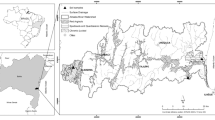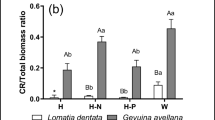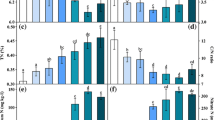Abstract
In arctic tundra soil, oxygen depletion associated with soil flooding may control plant growth either directly through anoxia or indirectly through effects on nutrient availability. This study was designed to evaluate whether plant growth and physiology of two arctic sedge species are more strongly controlled by the direct or indirect effects of decreased soil aeration. Eriophorum angustifolium and E. vaginatum, which originate from flooded and well-drained habitats, respectively, were grown in an in situ transplant garden at two levels of soil oxygen, nitrogen, and phosphorus availability over two growing seasons. In both species, N addition had a stronger effect on growth and biomass allocation than P addition or soil oxygen depletion. Net photosynthesis and carbohydrate concentrations were relatively insensitive to changes in these factors. Biomass reallocated from shoots to below-ground parts in response to limited N supply was equally divided between roots (nutrient acquisition) and perennating rhizomes (storage tissue formation) in E. angustifolium. E. Vaginatum only increased its allocation to rhizomes. In the flood-tolerant E. angustifolium, growth was improved by soil anoxia and biomass allocation among plant parts was not significantly affected. Contrary to our initial hypothesis, whole-plant growth in E. vaginatum improved in flooded soils; however, it only did so when N availability was high. Under low N availability growth in flooded soils was reduced by 20% compared to growth in the aerobic environment. Reduced biomass allocation to rhizomes and thus to storage potential under anaerobic conditions may reduce long-term survival of E. vaginatum in flooded habitats.
Similar content being viewed by others
References
Adams F (1980) Interactions of phosphorus with other elements in soils and plants. In: Khasawneh FE, Sample EC, Kamprath EJ (eds) The role of phosphorus in agriculture, Soil Science Society of America, Madison, pp 655–680
Armstrong W (1979) Aeration in higher plants. Adv Bot Res 7:255–332
Ashraf M, Yasmin H (1991) Differential waterlogging tolerance in three grasses of contrasting habitats: Aeluropus lagapoides (L.) Trin., Cynodon dactylon (L.) Pers. and Leptochloa fusca (L.) Kunth. Environ Exp Bot 31:437–445
Bliss LC (1981) North American and Scandinavian tundras and polar deserts. In: Bliss LC, Heal OW, Moore JJ (eds) Tundra ecosystems: a comparative analysis. Cambridge University Press, Cambridge, UK, pp 8–24
Bloom AJ, Chapin FS III, Mooney HA (1985) Resource limitation in plants — an economic analogy. Annu Rev Ecol Syst 16:363–392
Bradford KJ (1982) Regulation of shoot responses to root stress by ethylene, abscisic acid and cytokinin. In: Wareing PF (ed) Plant growth substances. Academic Press, New York, pp 599–608
Brändle R, Crawford RMM (1987) Rhizome anoxia tolerance and habitat specialization in wetland plants. In: Crawford RMM (ed) Plant life in aquatic and amphibious habitats. (British Ecological Society Special Publication) Blackwell, Oxford pp 397–410
Brouwer R (1966) Root growth of grasses and cereal. In: Milthorpe FL, Ivins JD (eds) The growth of cereals and grasses. Butterworth, London, pp 153–166
Chapin FS III (1980) The mineral nutrition of wild plants. Annu Rev Ecol Syst 11:233–260
Chapin FS III, Shaver GR (1985) Individualistic growth response of tundra plant species to environmental manipulations in the field. Ecology 66:564–576
Chapin FS III, Shaver GR, Kedrowski RA (1986) Environmental controls over carbon, nitrogen and phosphorus chemical fractions in Eriophorum vaginatum L: in Alaskan tussock tundra. J Ecol 74:176–195
Chapin FS III, Fetcher N, Kielland K, Everett KR, Linkins AE (1988) Productivity and nutrient cycling of Alaskan tundra: enhancement by flowing water. Ecology 69:693–702
Chapin FS III, Schulze E-D, Mooney HA (1990) The ecology and economics of storage in plants. Annu Rev Ecol Syst 21:423–447
Crawford RMM (1982) Physiological responses to flooding. In: Lange OL, Nobel PS, Osmond CB, Ziegler H (eds) Physiological plant ecology II. (Encyclopedia in plant physiology 12B) Springer, Berlin Heidelberg New York, pp 453–477
Dijkstra P (1989) Differences in specific leaf area. In: Lambers H, Cambridge ML, Konings H, Pons TL (eds) Causes and consequences of variation in growth rate and productivity of higher plants. SPB Academic Publishing. The Hague pp 125–140
Drew MC (1990) Sensing soil oxygen. Plant Cell Environ. 13:681–693
Drew MC, Sisworo EJ (1979) The development of waterlogging damage in young barley plants in relation to plant nutrient status and changes in soil properties. New Phytol 82:301–314
Everett KR, Brown J (1982) Some recent trends in the physical and chemical characterization and mapping of tundra soils, arctic slope of Alaska. Soil Sci 133:264–280
Gebauer RLE (1994) The effect of waterlogging on photosynthesis, nutrient status and growth of the Arctic species Eriophorum vaginatum and E. angustifolium. PhD dissertation, University of California, Davis
Gebauer RLE, Tenhunen JD, Reynolds JF (1995) Soil aeration in relation to soil physical properties, nitrogen availability, and root characteristics within an arctic watershed. Plant Soil (in press)
Gerritsen J, Greening HS (1989) Marsh seed banks of the Okefenokee swamp: effects of hydrologic regime and nutrients. Ecology 70:750–763
Giblin AE, Nadelhoffer KJ, Shaver GR, Laundre JA, McKerrow AJ (1991) Biogeochemical diversity along a riverside toposequence in arctic Alaska. Ecol Monogr 61:415–435
Grace JB (1988) The effects of nutrient additions on mixtures of Typha latifolia L. and Typha domingensis Pers. along a water depth gradient. Aquat Bot 31:83–92
Jaeger CH, Monson RK (1992) Adaptive significance of nitrogen storage in Bistorta bistortoides, an alpine herb. Oecologia 92:578–585
Johnson DA, Tieszen LL (1976) Aboveground biomass allocation, leaf growth, and photosynthesis patterns in tundra plant forms in arctic Alaska. Oecologia 24:159–173
Karlsson PS (1982) Ecology of deciduous and evergreen dwarf shrub: Vaccinium uliginosum and Vaccinium vitis-idaea in subarctic Fennoscandia. PhD dissertation, University of Lund, Sweden.
Koncalová H (1990) Anatomical adaptations to waterlogging in roots of wetland graminoids: limitations and drawbacks. Aquat Bot 38:127–134
Kozlowski TT, Pallardy SG (1984) Effect of flooding on water, carbohydrate and mineral relations. In: Kozlowski TT (ed) Flooding and plant growth. Academic Press, New York, pp 165–193
Kramer PJ (1981) Carbon dioxide concentration, photosynthesis and dry matter production. Bioscience 20:1201–1208
Kummerow J, Krause D (1982) The effects of variable nitrogen and phosphorous concentrations on Eriophorum vaginatum tillers grown in nutrient solutions. Holarct Ecol 5:187–193
Laan P, Blom CWP (1990) Growth and survival responses of Rumex species to flooded and submerged conditions: the importance of shoot elongation, underwater photosynthesis and reserve carbohydrate. J Exp Bot 41:775–783
Lambers H, Poorter H (1992) Inherent variation in growth rate between higher plants: a search for physiological causes and ecological consequences. Adv Ecol Res 23:187–261
Leadley PW, Reynolds JF (1992) Long-term response of an arctic sedge to climate change: a simulation study. Ecol Appl 2:323–340
Limbach WE, Oechel WC, Lowell W (1982) Photosynthetic and respiratory responses to temperature and light of three Alaskan tundra growth forms. Holarct Ecol 5:150–157
Matthes-Sears U, Matthes-Sears WC, Hastings SJ, Oechel WC (1988) The effects of topography and nutrient status on the biomass, vegetation characteristics, and gas exchange of two deciduous shrubs on an arctic slope. Arct Alp Res 20:342–351
McGraw JB, Shaver GR (1982) Seedling density and seedling survival in Alaskan cotton grass tussock tundra. Holarct Ecol 5:212–217
Megonigal JP, Day FP (1992) Effects of flooding on root and shoot production of bald cypress in large experimental enclosures. Ecology 73:1182–1193
Mendelssohn IA, Postek MT (1982) Elemental analysis of deposits on the roots of Spartina alterniflora Loisel. Am J Bot 69:904–912
Mooney HA, Winner WE (1991) Partitioning response of plants to stress. In: Mooney HA, Winner WE, Pell EJ (eds) Response of plants to multiple stresses. Academic Press, New York, pp 129–141
Musgrave ME, Vanhoy MA (1989) A growth analysis of waterlogging damage in mung bean (Phaseolus aurens). Can J Bot 67:2391–2395
Naidoo G, Naidoo S (1992) Waterlogging responses of Sporobulus virginicus (L.) Kunth. Oecologia 90:445–450
Neil C (1990) Effects of nutrient and water levels on emergent macrophyte biomass in a prairie marsh. Can J Bot 68:1007–1014
Nye PH, Tinker PB (1977) Solute movement in the soil-root system. University of California Press, Berkeley
Oberbauer SF, Hastings SJ, Beyers JL, Oechel WC (1989) Comparative effects of downslope water and nutrient movement on plant nutrition, photosynthesis, and growth in Alaskan tundra. Holarct Ecol 12:324–334
Olsen SR (1972) Micronutrient interactions. In: Mortvedt JJ Dinnaur RC (eds) Micronutrients in agriculture. Soil Science Society of America. Madison, pp 243–264
Pearson J, Havill DC (1988) The effect of hypoxia and sulphide on culture-grown wetland and non-wetland plants. J Exp Bot 39:363–374
Peterson DL, Bazzaz FA (1984) Photosynthetic and growth responses of silver maple (Acer saccharinum L.) seedlings to flooding. Am Midl Nat 112:262–272
Ponnamperuma FN (1972) The chemistry of submerged soils. Adv Agron 24:29–96
Poorter H, Remkes C (1990) Leaf area ratio and net assimilation rate of 24 wild species differing in relative growth rates. Oecologia 83:553–559
Reddy KR, Feijtel TC, Patrick WH Jr (1986) Effect of soil redox conditions on microbial oxidation of organic matter. In: Chen Y, Avnimelech Y (eds) The role of organic matter in modern agriculture. Nijhoff., Dordrecht, pp 117–156
Regehr DL, Bazzaz FA, Boggess WR (1975) Photosynthesis, transpiration and leaf conductance of Populus deltoides in relation to flooding and drought. Photosynthetica 9:52–61
Reynolds JF, Thornley JHM (1982) A shoot:root partitioning model. Ann Bot 49:585–597
Saglio PH, Raymond P, Pradet A (1984) Critical oxygen pressure for growth and respiration of excised and intact roots. Plant Physiol 76:151–154
Setter TL, Waters I, Greenway H, Aywell BJ, Kupkanchanakul T (1987) Carbohydrate status of terrestrial plants during flooding. In: Crawford RMM (ed) Plant life in aquatic and amphibious habitats. Blackwell, Oxford, pp 411–433
Shaver GR, Chapin FS III, Gartner BL (1986) Factors limiting seasonal growth and peak biomass accumulation in Eriophorum vaginatum in Alaskan tussock tundra. J Ecol 74:257–278
Smith D (1969) Removing and analyzing total nonstructural carbohydrates from plant tissue. Research report No 41, Research Division, College of Agricultural and Life Science, Madison, p 11
Steinlein T, Heilmeier H, Schulze E-D (1993) Nitrogen and carbohydrate storage in biennials originating from habitats of different resource availability. Oecologia 93:374–382
Tang ZC, Kozlowski TT (1984) Water relations, ethylene production and morphological adaptation of Fraxinus pennsylvanica seedlings to flooding. Plant Soil 77:183–192
Teng Y, Timmer VR (1990) Phosphorus-induced micronutrient disorders in hybrid poplar. Plant Soil 126:19–29
Tissue DT, Oechel WC (1987) Response of Eriophorum vaginatum to elevated CO2 and temperature in the Alaskan tussock tundra. Ecology 68:401–410
Trought MCT, Drew MC (1980) The development of waterlogging damage in wheat seedlings (Triticum aestivum L.). II. Accumulation and redistribution of nutrients by the shoot. Plant Soil 56:187–199
Vitousek P (1982) Nutrient cycling and nutrient use efficiency. Am Nat 119:553–572
Walker DA, Binnian E, Evans BM, Lederer ND, Nordstrand E, Webber PJ (1989) Terrain, vegetation, and landscape evolution of the R4D research site, Brooks Range Foothills, Alaska. Holarct Ecol 12:238–261
Wample RL, Davies RW (1983) Effect of flooding on starch accumulation in chloroplasts of sunflower (Helianthus annuus L.). Plant Physiol 73:195–198
Webber PJ (1978) Spatial and temporal variation of the vegetation and its productivity, Barrow, Alaska. In: Tieszen LL (ed) Vegetation and production ecology of an Alaskan Arctic tundra. Springer, Berlin Heidelberg New York, pp 37–112
Weissner SEB (1988) Factors affecting the internal oxygen supply of Phragmites australis (Cav). Trin. Ex Steudel in situ. Aquat Bot 31:329–335
Author information
Authors and Affiliations
Corresponding author
Rights and permissions
About this article
Cite this article
Gebauer, R.L.E., Reynolds, J.F. & Tenhunen, J.D. Growth and allocation of the arctic sedges Eriohorum angustifolium and E. vaginatum: effects of variable soil oxygen and nutrient availability. Oecologia 104, 330–339 (1995). https://doi.org/10.1007/BF00328369
Received:
Accepted:
Issue Date:
DOI: https://doi.org/10.1007/BF00328369




